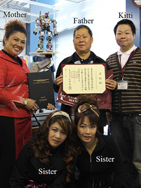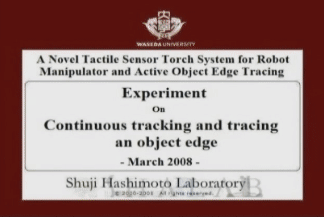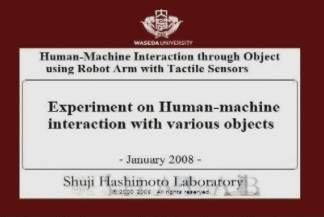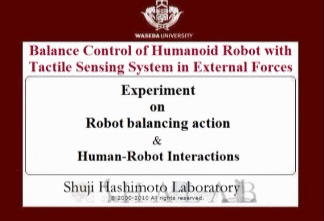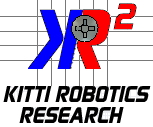RESEARCH FIELD
Research Theme (研究テーマ) :
"A Research Regarding Development & Application of Tactile Sensing for Robots"
This research presents the tactile sensor system for robots and various active sensing techniques. We have developed a new tactile sensor unit which is one of the simple implementations structured with minimum number of sensing elements to reduce the development costs. The proposed technique is to use three force sensitive resistors (FSRs) arranged triangularly. The proposed sensor unit was applied to industrial robot and humanoid robot. The developed systems implemented on these robots are able to detect the orientations of planar surfaces and force orientation with the temporal tendency. My method is a sort of distributed sensory-motor feedback with simple control strategy. To confirm the suitability of the propose method, we introduce three practical applications as following;
Research outline (研究概要) :
"ロボットの ための触覚センシングの開発とその応用に関する研究"
本研究ではロボットのための触覚センサシステムと複数のセンサ技術の応用例について紹介する。我々は開発コストを削減するため、最低限のセンサだけを有した単純な構造を持つ触角センサを開発している。我々は三角形上に配置された3つの圧力センサ(FSR)を用いた触覚センサを開発し、産業用ロボットやヒューマノイドロボットに適用している。これらのロボットに実装されたシステムは物体平面の姿勢や力の方向およびその時間的な変化を検知することが可能である。私の方法は一種の分散センサとモータのフィードバックシステムになっている。本手法の応用可能性を示す事例として、我々は以下のような3つの事例を紹介する。
In this research topic, we aim to realize the proposed method for improving the safety and efficiency of industrial task. Welding is the most application of robot in the industrial field. Recently, it is often required that human to be close to the robot for teaching them about the object information such as the welding positions before doing the welding task. Thus, we attempted to employ the proposed system as an automatic replacement of manual teaching. In order to achieve this aim, we developed a novel welding torch for industrial robot. It can recognize objects information as well as the robot motion planning for welding.
1. Industrial applications (産業応用) :
本研究において我々は産業用ロボットの安全性と効率性を高めるための方法の確立を目指している。溶接は産業界におけるロボットの応用先としてもっとも多い応用例の一つであるが、溶接作業を行う前に、物体の情報を手動でロボットに教えるために、人間がしばしばロボットに近づく必要があり、非常に危険である。我々は、この問題を解決するため、触覚システムを用いて手動での教示を代替するような新しい自動軌跡検知システムの開発を試みている。この目的を実現するため、我々は産業用ロボットのための新しい溶接トーチを開発した。本システムを用いることで、物体の情報を自動的に検知し、溶接のための自動的なモーションプランニングが可能な自動溶接システムを実現することが出来た。
In this research topic, we focus on a cooperative work between human and robot in a natural and intuitive manner. The next generation robots should be able to cooperated work with human autonomously. An applicable idea of cooperative task is to move the large object together. During the moving task, human might not be able to maintain the object orientation such as angle and level from the floor due to the object weight. The proposed tactile sensor is implemented on the robotic hand that can estimate the contact angle between the sensor and an object to be touched. Then the robot will move its hand for support holding an object. Moreover, robot can understand the human partner’s intention by detecting the applied force through the object.
2. Human-Robot Interactions (人間-ロボット・インタラクション応用) :
本研究は人間とロボットの間の自然で直感的な方法での協調作業に関するものである。次世代のロボットは人間と自動的に協調作業ができるようになる必要がある。特に、物体が非常に重く、人間だけでは物体を保持することができないような状況では、大きな物体をロボットと共に動かすことが必要になる。開発したロボットは、実装された触覚センサを用いることでセンサと物体の間の接触角度を推定することが可能であるため、物体からの力を通して人間の意図を感じ取り、物体を支えるようにその手を動かし、人間を常にサポートすることができる。
This research focuses on a development of an autonomous humanoid robot by combining the above two applications. Humanoid robot is a bipedal architecture mechanism which is one of the most versatile setups, which is highly suitable for working in human environments. Accordingly, we introduced a novel method of walking pattern generation by applying the proposed tactile sensing technique to make the current biped walking system simpler by utilizing a real time tactile feedback instead of the complex ZMP calculations. Our idea is to use sensors with a specialized layout implement into the back of robot feet to enable the robot to balance and walk on different uneven grounds. We also show the example of balance control when the human pushes the robot. The information about ground floor or robot orientation is not required in advance.
3. Humanoid robot applications (人型ロボット応用) :
本研究は上記2つの応用例を組み合わせた自律移動型ヒューマノイドロボットの開発に関するものである。 人間型ロボットは、 人間と同じ姿を持つという特性のため、人間環境への導入にもっとも適した構造を持つロボットの一つであると考えられるが、人間環境でバランスを取り、安定して歩行動作を実現することは依然として難しい。我々は複雑なZMP計算を行う代わりに触覚システム からのリアルタイムでのフィードバック情報を利用することでヒューマノイドロボットの歩行動作をより簡素化することを目指している。 我々は提案するセンサをヒューマノイドロボットの足裏に設置することで、様々な平らでない床の上でバランスを取りながら、安定して歩行が可能なヒューマノイドロボットを実現したいと考えている。 また、 人間がロボットを押したときにもバランスを保つことが可能だ。本システムでは、バランス制御を行う際、床の情報やロボットの姿勢に関する情報を事前に得ておく必要はない。
 | ||||||
 | ||||||
 | ||||||
 | ||||||
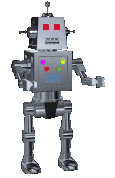
早稲田大学
WASEDA UNIVERSITY
I T T I O B O T I C S E S E A R C H
K
I
T
T
I
I
R
R
R
O
O
E
E
S
S
C
B
T
C
A
H
K
R
R



